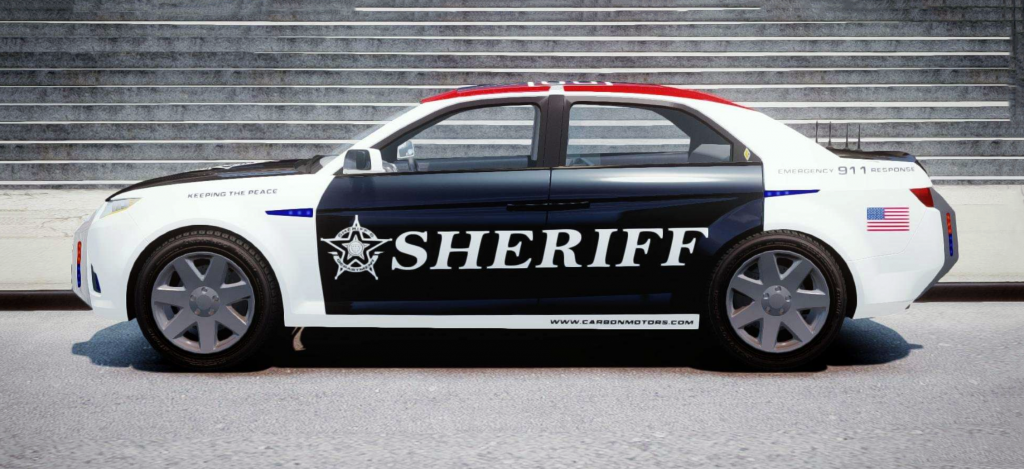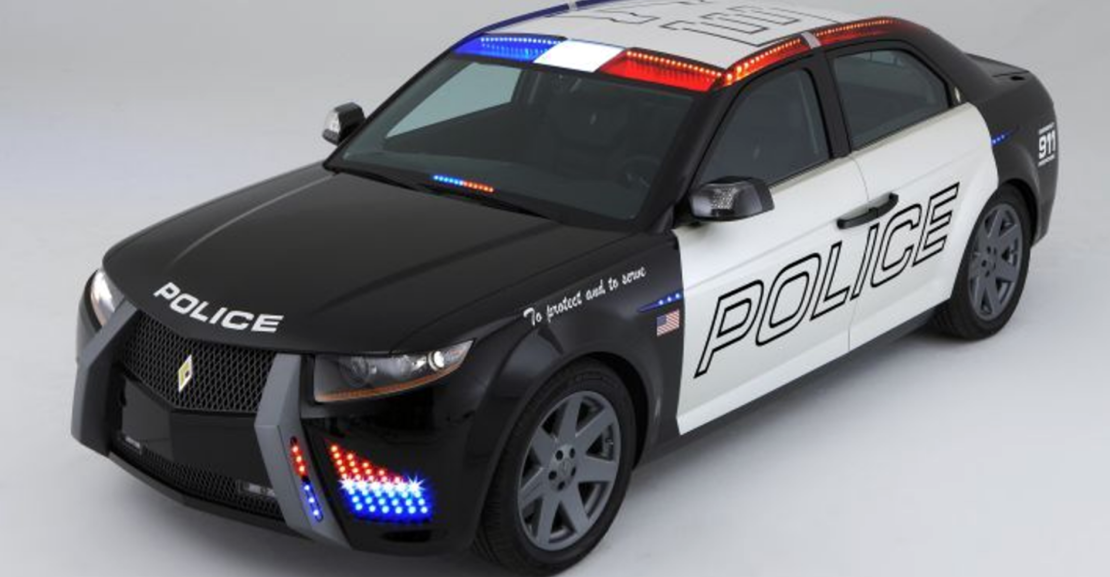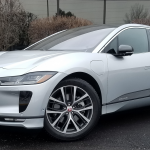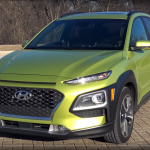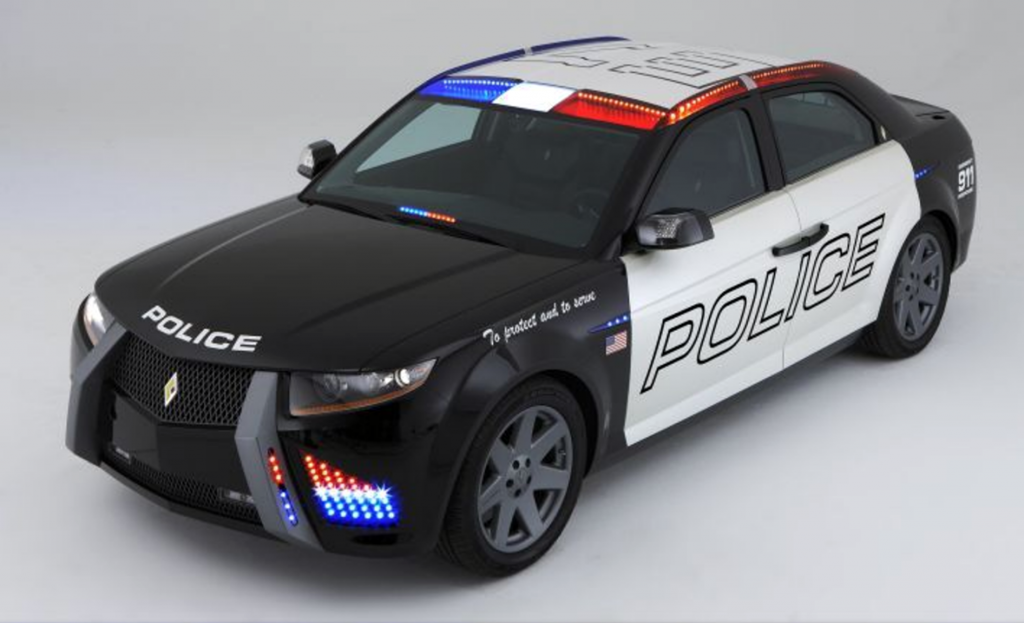
Text by Chris Poole
On March 22, 2010, the Carbon Motors Corporation placed an order with German automaker BMW for almost a quarter of a million 6-cylinder diesel engines. Obviously, Carbon Motors’ management was feeling optimistic about the firm’s business prospects.
What Was The Carbon E7?
Background
And why wouldn’t they be? Carbon’s first product, a dedicated law-enforcement sedan, was scheduled to arrive at what seemed to be the perfect time to make inroads into the police-vehicle market.
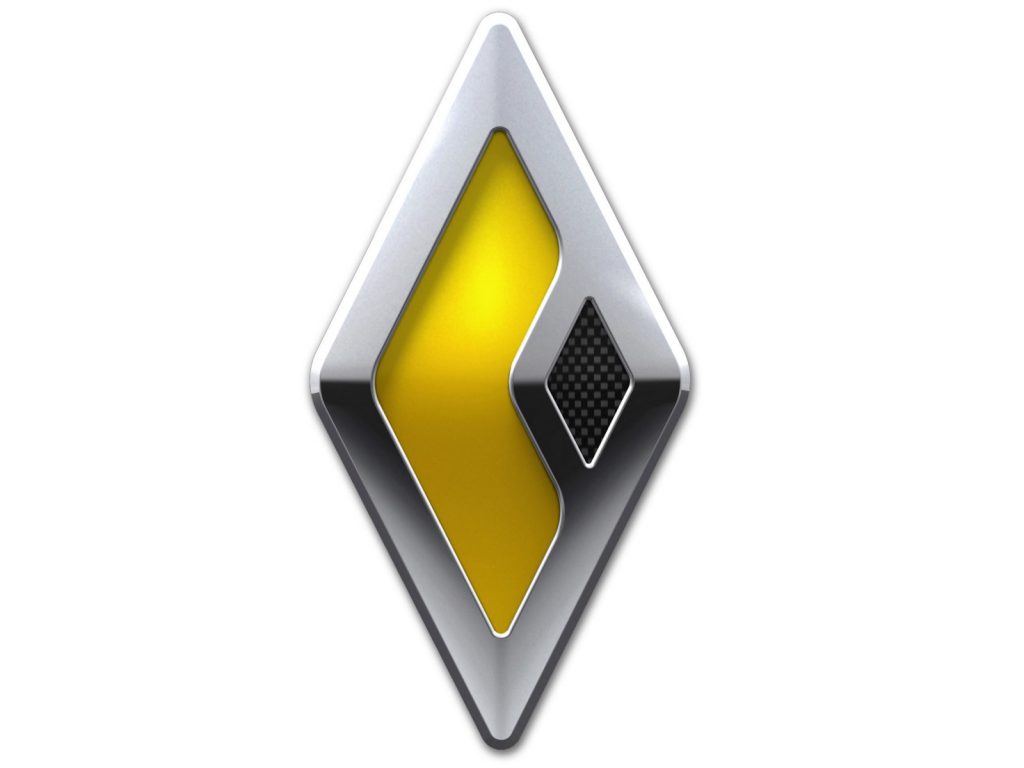
With gas prices having reached all-time highs in 2008, law-enforcement agencies had become more cost conscious in regards to patrol-vehicle purchases. While the ubiquitous Ford Crown Victoria wasn’t egregiously inefficient, it wasn’t exactly easy on the gas. The potent Dodge Charger, also popular with police fleets, made an excellent pursuit vehicle, but its 5.7-liter Hemi V8 consumed gasoline at an alarming rate.
Enter the Carbon E7, a futuristic-looking 4-door sedan that was designed from the start to be a police car. The E7 promised to be more fuel efficient than traditional passenger-car-based police cars, and it was also engineered to be much less expensive to operate over time, thus lowering ongoing fleet-upkeep costs.
Looking back, it’s not hard to imagine these rakish sedans in black and white livery patrolling the streets of local municipalities. Alas, as is usually the case with start-up businesses, funding proved to be Carbon’s downfall.
Carbon Motors’ business plan included a loan from the U.S. Department of Energy of $320 million. These funds were to be made through the agency’s Advanced Technology Vehicle Manufacturing (ATVM) program, which was established to help manufacturers develop alternative-fuel cars and trucks. The funding fell through, however, leaving Carbon without sufficient capital to initiate production.
What follows here is Consumer Guide’s original Future Car report on the E7, written in 2009 by now-retired editor Chris Poole.
More law-enforcement vehicle fun
Future Car: 2012 Carbon E7
Consumer Guide’s Impressions of the 2012 Carbon E7
It’s the world’s first car designed for law enforcement by law enforcement. You won’t ever be able to buy one, but the American-built Carbon E7 should save taxpayer bucks while it serves and protects the police.
What We Know About the 2012 Carbon E7
It looks like something Robocop might drive, but the 2012 Carbon E7 is serious business: the world’s first purpose-designed police car. Or as Atlanta-based Carbon Motors describes it, a “homeland security” vehicle created for law enforcement by law enforcement.
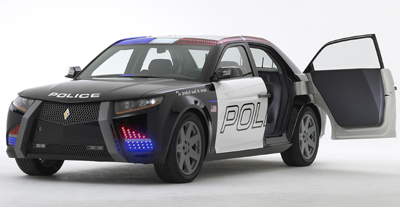
This is no everyday police-package Ford Crown Victoria or Chevrolet Impala. The 2012 Carbon E7 is new from the ground up, engineered and equipped to enhance comfort, effectiveness and personal safety for America’s 800,000 law-enforcement officers. And though it’s a way-cool machine with undoubted consumer appeal, the E7 will never be sold to the public, new or used. But be warned. Law-enforcement officials throughout the land are said to be very excited about this project, so you should see E7s on the road starting in 2012, if all goes according to plan.
According to a recent article in Police magazine, the 2012 Carbon E7 story begins with Stacy Dean Stephens, a former patrol officer in the Dallas suburb of Coppell, Texas. Stephens wondered why no one had bothered to offer a specially designed police car in over 100 years of automotive history. After all, soldiers, firefighters, emergency medical techs and other first-responders have vehicles custom-tailored for their jobs. Why not police officers? But though Stephens’ resolve was strengthened by the death and injury of several colleagues in patrol-car accidents, he couldn’t persuade established automakers to build an only-for-cops car. Not enough money in it, they told him.
Then he heard about entrepreneur William Santana Li (pronounced “Lee”), a former Ford Motor Company executive with global experience. Li quickly signed on to Stephens’ idea, seeing an important but underserved market that also represented an untapped profit opportunity. As he told Police, “I was looking at various niches, and law enforcement was on my radar when Stacy contacted me.”
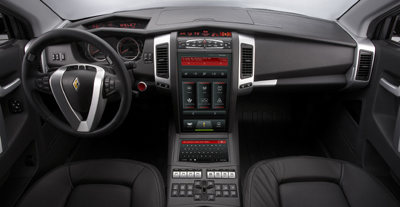
The two men set up Carbon Motors soon after September 11th tragically dramatized the need for a “homeland security” vehicle, not just a fancier patrol car. With Li as board chairman and CEO, a team of engineers and manufacturing experts was assembled, most of whom had also worked at Ford. Among them are four executive vice-presidents: Chief Strategy Officer Andrew B. Savarie; CFO Keith R. Marchiando; Chief Production Officer Alan J. Bratt; and, heading up engineering, Chief Development Officer Trevor J. Rudderham.
To be sure the finished product would suit its customers’ particular needs, Stephens decided to form a “Carbon Council” to solicit design suggestions from police officers ranging from campus patrols to big-city departments. Some 2,500 individuals have contributed so far. To establish corporate credibility with lenders and governmental bodies, Carbon also set up an Advisory Board comprising three heavy-hitters: Thomas Ridge, the former Pennsylvania governor and first Secretary for the Department of Homeland Security (DHS); former Indiana Congressman Lee Hamilton, whose many top-level posts include serving as vice-chair of the 9/11 Commission; and Dr. Lee P. Brown, a career law-enforcement professional and a former mayor of Houston who now heads a consultancy, Brown Group International.
Why the name Carbon Motors? As the company’s website explains, “carbon, in its purest organic form, is a fundamental building block of life. Life is a common fiber through [our] focus on homeland security, American jobs and environmental responsibility. Carbon is life. We protect and serve life…The diamond shape in our logo represents the strongest, most durable and sought after form of carbon.”
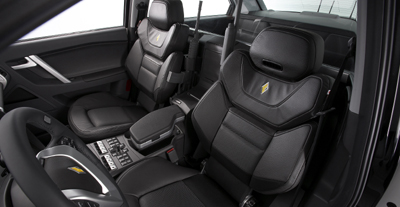
Not surprisingly, the 2012 Carbon E7 aims to satisfy a long list of requirements, starting with cost. According to Li, the U.S. has some 19,000 law-enforcement agencies that are not regulated by the DHS or the Department of Justice. This leaves each agency to negotiate with carmakers and/or dealers for vehicle purchases and with a multitude of suppliers for lights, radio, radar, and other police-specific equipment. The result is often a compromise vehicle costing upwards of $80,000, yet one that is little safer or more durable than the retail passenger car on which it’s based. Worse, it uses no less fuel and takes as much time and money to repair. Taxpayers, of course, foot all these bills.
Moreover, as Li notes, retiring a police car entails the added expense of removing all the “upfit” equipment and sometimes repainting the vehicle for resale, typically to taxi fleets but also to the occasional private buyer. But that kind of recycling, combined with easy availability of realistic uniforms, only makes it easier to impersonate officers, which encourages certain types of crime. And even if a law-abiding citizen buys one, a used cop car is often pretty scruffy, which undermines the “command image” that police departments strive to project for reasons of public support and cooperation.
Law-Enforcement Madness! 35 Police Car Brochure Covers
Then there’s the practical side. Police officers can be on duty for 12 hours or more, so the car they “live” in must be not only properly equipped but comfortable. It should also help protect officers should they come in harm’s way, as well in accidents. Speed and top-flight handling are taken for granted, but Carbon thinks police cars should also be easier on fuel and lower on emissions than comparable civilian models.
It’s these and other considerations that separate the 2012 Carbon E7 from ordinary cars. Though it looks a bit like the Dodge Charger, another law-enforcement staple, and is even much the same size, the E7 eschews conventional construction for an aluminum “spaceframe” carrying thermoplastic body panels and all running gear. General Motors’ original S-Series Saturns took this same approach, albeit with a steel “skeleton.” But as with those compact cars, the E7’s body panels resist dings and can be swapped out easily and quickly, reducing downtime for repairs. And because the color is molded into the panels, Carbon didn’t have to set up an elaborate paint shop that would have added to manufacturing costs.
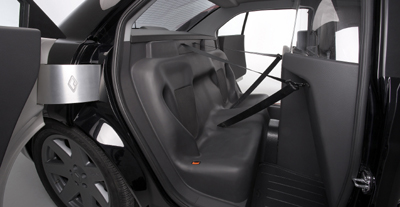
Unlike most police cruisers, the 2012 Carbon E7 has no obvious external add-ons. The familiar “pushbars”, for example, are mean-looking uprights tied to the strong internal structure (engineered with help from legendary sports-car maker Lotus of England). The customary rooftop “lollipop” lights are housed within the roof siderails and the upper windshield and rear window, this to reduce high-speed air drag as a small aid to fuel economy. For the same reason, spotlights are modern high-intensity LED units tucked within the door-mirror housings. Other lights mount within the lower front and rear fascias.
There’s more stealthy tech elsewhere on the 2012 Carbon E7. A pair of sensors in ducts atop the rear fenders “sniff” the air for chemical, biological or radiation hazards. Front and rear radar sensors are set behind bumper fascias so personnel won’t be exposed to that radiation threat. A bevy of security cameras provides full-perimeter exterior coverage. Still other cameras read license plates and provide infrared “night vision.” Also enhancing officer safety is a standard fob-in-pocket keyless-entry and starting system that automatically locks up to prevent theft when the car is unoccupied. It can also be used for remote starting, as on many civilian cars.
6 Coolest Police Vehicles of 2018
The 2012 Carbon E7 was deliberately styled with minimal metal at the corners, this to optimize approach and departure angles for negotiating difficult terrain. It is also engineered to exceed Federal Motor Vehicle Safety standards. In fact, Carbon says the E7 will absorb a 75-mph rear-end collision with no fuel-tank leakage, a problem that plagued police-equipped Crown Victorias some years ago. Also enhancing officer protection are bullet-resisting Kevlar reinforcements in the front-door and dashboard areas, plus the expected front, side, and side-curtain airbags. Last but not least, the E7 has rear “coach doors” that hinge from the back to swing out a full 90 degrees, this to ease the “insertion and removal of combative subjects.”
Being reserved for perps, the rear passenger cell of the 2012 Carbon E7 is completely isolated from the front compartment by a full-height divider with an upper window. Most all the space, seat included, is made of plastic so it can be hosed clean when needed; floor holes are provided for draining rinse water or other, er, “fluids.” Suspects are held firmly in place by three-point seatbelts that spool out from inboard anchors. The belt buckle unclips from the divider wall so an officer doesn’t have to reach across when belting up a suspect and thus run the risk of bite injuries. Of course, there are no door handles or window winders back there.
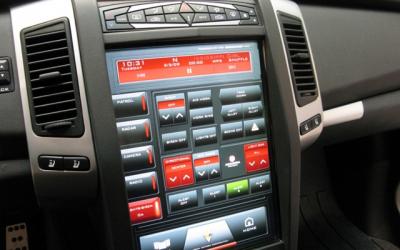
Up front, the 2012 Carbon E7 is a combination mobile office and command center. Gauges and routine driving controls group ahead of a tilt and telescopic steering wheel; a dashtop radar-data display sits just below the driver’s forward sightline. Climate controls mount atop the center stack. Directly below is a multifunction 15-inch touch-screen that works with a compact wireless keyboard stowed in a center-console well. Besides eliminating the clumsy carry-on components found in conventional patrol cars, the E7 communications system utilizes the Onboard Rapid Command Architecture (ORCA) that links the vehicle with central dispatch, crime databases and even other police cars. The screen also displays images from the various onboard cameras, including a special back-seat “eye,” as well as maps for an included navigation system that can also track vehicles equipped with locator devices like LoJack. The screen can also be used to control lights, sirens, radios, and PA system, all of which are covered by redundant switches on the console and steering wheel. A pair of jumbo heated-and-cooled cupholders nestles between the seat cushions. A pair of gun holders lives on the divider wall between the seatbacks, along with storage for a compact computer printer. A lidded center-dashtop bin has room for pens, ticket books and such. Red interior lighting minimizes nighttime eye strain, and LED pin-spots light up paperwork without drawing possibly dangerous attention.
Front seats in the 2012 Carbon E7 look more like executive chairs. Developed by Lear Corporation, they have modest side bolsters on the cushions and upper seatbacks, but are cut away at hip level so that an officer with a beltload of gear–revolver, nightstick, handcuffs, and such–can get in and out in a hurry or be comfortable for long spells. The seats are heated and cooled, as you might imagine. Upholstery is reinforced with Kevlar to be extra hard-wearing. Because many officers are of XL stature, the divider wall is shaped to provide more seat travel for the driver, as well as extra rear kneeroom on the right.
In other respects, the 2012 Carbon E7 is more like regular cop cars with the singular exception of its 3.0-liter turbocharged diesel engine, the only one available. This is believed to be a BMW inline 6-cylinder unit, though Carbon doesn’t disclose a supplier or even the number of cylinders. However, the company does admit to 300 horsepower and 420 pound-feet of torque. That’s claimed to be sufficient for vaulting the two-ton E7 from 0 to 60 mph in 6.5 seconds with the mandatory 6-speed automatic transmission. Top speed is electronically limited to 155 mph. That performance should allow E7s to keep up with most anything short of Corvettes, Ferraris, Lamborghinis, or Porsche 911s.
Cop-Car Walk-around: 2012 Chevrolet Caprice PPV
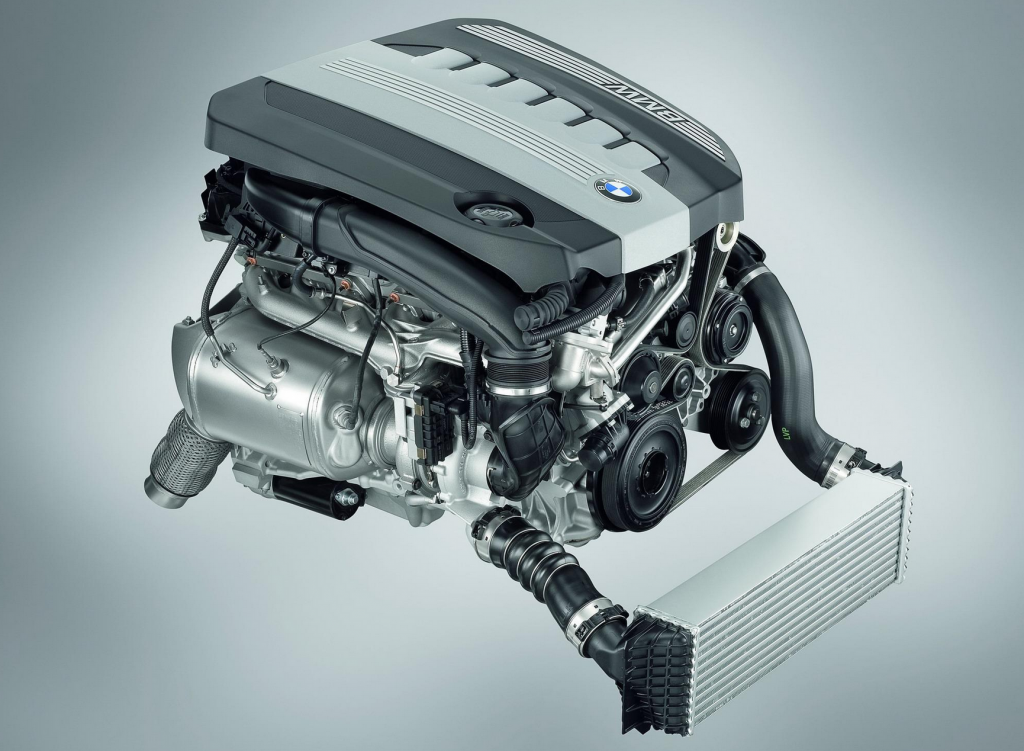
Fuel economy is perhaps even more impressive, with Carbon quoting 28-30 mpg on the EPA combined-driving cycle. That compares with 18-22 mpg for police-equipped Chrysler, Ford and General Motors models. Of course, the E7 needs diesel fuel, which costs more per gallon than gasoline, but it does run on cheaper biodiesel fuel, which should be a plus for law-enforcement agencies facing budget cutbacks. So, too, the E7’s claimed 250,000-mile service life, which we gather is about twice that of patrol cars based on retail models.
The 2012 Carbon E7 suspension is a conventional design with heavy-duty coil springs, front struts, multilink rear geometry with self-leveling shock absorbers, and an antiroll bar at each end. Brakes are vented 4-wheel discs with ABS measuring 14 inches across in front and 13 inches in back. Tires are 245/50R18s wrapped on 8-inch-wide steel wheels. Interestingly, Carbon claims front/rear weight distribution at a BMW-like 50/50, which should complement the chassis hardware to deliver demon handling despite the burly curb weight.
Only one 2012 Carbon E7 has been built so far, a “proof of concept” prototype that’s being used to drum up interest among law-enforcement agencies, potential investors and, of course, governmental bodies. Motor Trend says the design will be optimized in the months leading up to production, which CEO Li expects will kick off in 2012. Meantime, MT says, the E7 will “likely compete in official police-vehicle assessments conducted by the Michigan State Police.” It will be interesting to see what the Big-Three opponents might be, if any.
For now, the 2012 Carbon E7 seems a promising and passionate answer to a question nobody thought to ask before. We’ll continue to follow this story, so keep checking back for late developments.
Cop-Car Walk-around: 2012 Dodge Charger Police Car
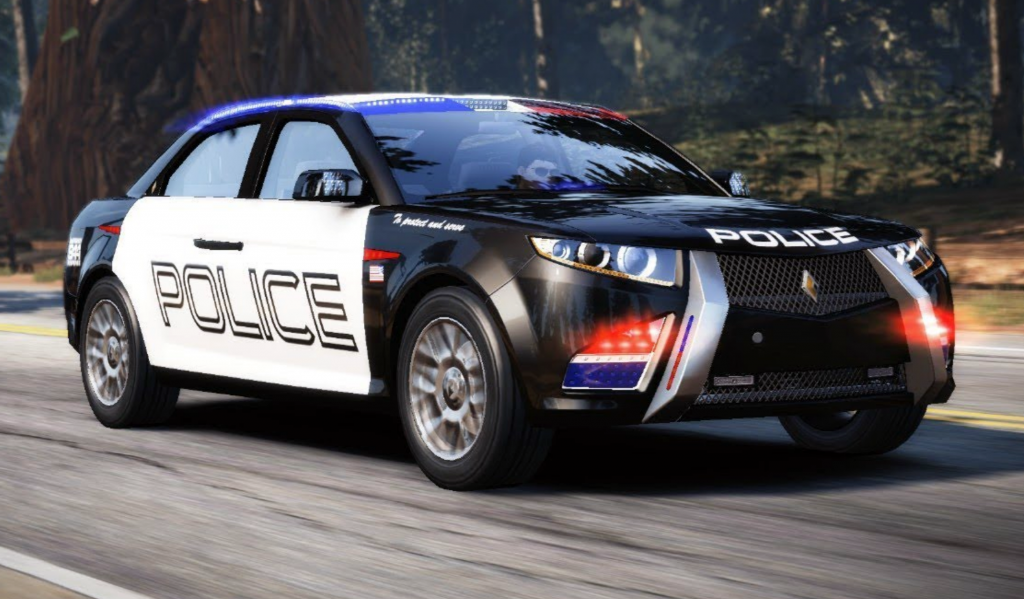
A Notable Feature of the 2012 Carbon E7
As we hope the above makes clear, the 2012 Carbon E7 is obviously packed with notable features, and there are others we’ve haven’t mentioned yet. For example, as part of its plan to reduce lifetime unit costs by up to 40 percent compared with conventional police cars, Carbon Motors plans to take back used E7s for recycling, either by retrofitting and refurbishing for resale or by dismantling for reusable parts. Carbon claims the E7 is 95 percent recyclable by content, which is possibly the best such figure in the industry. It’s also consistent with the company’s goal of doing business with minimal environmental damage. Carbon has yet to spell out how the repurchase scheme will work, but that’s one of the issues we’ll be following.
One more thing: Though the deepening global recession makes this a lousy time for new automaking ventures, Carbon is confident that it will be profitable on “mid-volume” production of 10,000-80,000 E7s per year. As noted above, the car was designed to minimize manufacturing costs, as well to optimize build quality. After all, the last thing harried law-enforcement agencies want are overpriced, poorly built cruisers that waste taxpayer dollars.
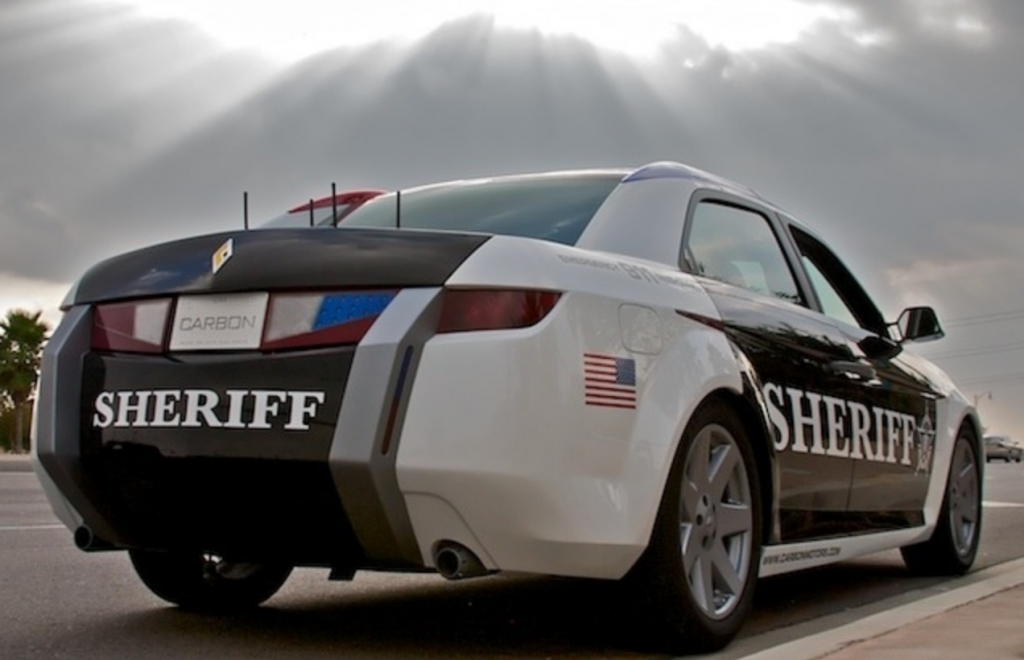
Buying Advice for the 2012 Carbon E7
There’s none to offer here, because the 2012 Carbon E7 will be sold only to law-enforcement agencies, period. The good news for Carbon Motors is that over 1,000 departments have so far expressed interest in the vehicle, according to CEO Li, who also pegs the total U.S. police-vehicle market at a sizeable 425,000 units. The prototype is still being shown to forces around the country, following 2008’s lengthy “Justice Tour” that ended in San Diego with a display at the annual meeting of the International Associations of Chiefs of Police. Several foreign police forces have also shown interest, partly, we suspect, because diesel engines are the norm in many countries and the E7 has one.
2012 Carbon E7 Release Date:
As mentioned, Carbon Motors plans to start E7 production sometime during 2012. A firm date will likely be announced by the first of that year, if not sooner.
2012 Carbon E7 First Test Drive:
Carbon Motors may be target a niche market, but it will likely keep the media fully informed on the E7’s progress from prototype to production, if only to build public awareness and even political support for the project. When might we get actual seat time? Hard to say, but we’re hoping for at least a brief drive by the end of 2010.
2012 Carbon E7 Prices:
As things stand now, Carbon will announce E7 pricing in the fourth quarter of 2009, according to the company’s wesbite. CEO Li notes that current law-enforcement vehicles run between $30,000 and $80,000 each, depending on equipment. The average, he says, is around $55K, which leads us to think that the E7 will be close to that mark.
Chevrolet Caprice PPV: Cop Motor, Cop Tires, Cop Suspension, Cop Shocks
The Basics
Vehicle Type: large car
Drivetrain (manufacturer data)
Drive wheels: rear
Engine: 3.0-liter turbodiesel V6
Horsepower: 300
Torque: 420 lb-ft
Transmission: 6-speed automatic
Specs (manufacturer data)
Wheelbase: 122.0 inches
Length: 200.0 inches
Width: 78.0 inches
Height: 64.2 inches
Base curb weight: 4,000 pounds
